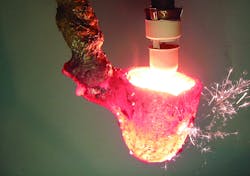Compacted-graphite iron technology supplier SinterCast AB reported increases in CGI production by its licensees during the first quarter of 2018, with a 25% year-on-year rise for the period. The first quarter also brought the start of CGI production at the Luitpoldhütte AG foundry in Germany (a manufacturer of cast parts for commercial vehicle, agricultural machinery, and off-highway equipment), as well as a new order for a SinterCast Mini-System 3000 for commercial-vehicle cylinder head production at Sanlian Casting in China.
The SinterCast process control technology is the most widely used production system for CGI — a grade of cast iron that has greater tensile strength, stiffness, and fatigue strength than gray iron or aluminum. CGI is increasingly popular with diesel and gas engine manufacturers seeking to reduce weight, noise, and emissions for their designs.
SinterCast reported CGI series production by its customers hit a record annualized total of 2.5 million "engine equivalents" (i.e., 125,000 metric tons, as one engine equivalent represents 50 kg) during the first quarter of 2018, a 25% year-on-year increase.
“The increase was primarily driven by the recovery of three high-volume programs, plus the start of production of V8 and V12 cylinder blocks for industrial power applications at the Luitpoldhütte foundry in Germany,” commented SinterCast CEO Dr. Steve Dawson. “The Luitpoldhütte SOP (start of production), combined with the continued ramp-up of industrial power production at the Caterpillar foundry in the United States, provided 58% year-on-year growth in the industrial power sector.
“The production of automotive components other than cylinder blocks and heads also increased during the quarter, with increased turbocharger housing production in China and increased volumes for the bedplate of the FCA 3.0 liter V6 diesel engine,” Dawson added.
The production rate rose even higher, to an annualized rate of 2.7 million engine equivalents during March, he noted, “providing a strong start and reinforcing the positive outlook for the year.”
About the Author
Robert Brooks
Content Director
Robert Brooks has been a business-to-business reporter, writer, editor, and columnist for more than 20 years, specializing in the primary metal and basic manufacturing industries. His work has covered a wide range of topics, including process technology, resource development, material selection, product design, workforce development, and industrial market strategies, among others.

